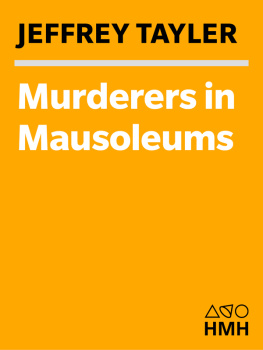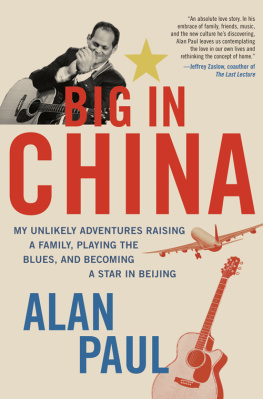Copyright 2009 by Jeffrey Tayler
All rights reserved
For information about permission to reproduce selections from this book, write to Permissions, Houghton Mifflin Harcourt Publishing Company, 215 Park Avenue South, New York, New York 10003.
www.hmhbooks.com
The Library of Congress has cataloged the print edition as follows:
Tayler, Jeffrey.
Murderers in mausoleums : riding the back roads of empire
between Moscow and Beijing / Jeffrey Tayler.
p. cm.
ISBN 978-0-618-79991-6
1. AsiaDescription and travel. 2. Former Soviet republicsDescription and travel. 3. Tayler, JeffreyTravelAsia. 4. Tayler, JeffreyTravelFormer Soviet republics. I. Title.
DS 10. T 37 2009 915.0443dc22 2008013302
e ISBN 978-0-547-52382-8
v1.0513
NOTE Certain names and minor identifying characteristics have been changed to protect the privacy of people described in this book. Specifically, the following names are pseudonyms: Ahmad in chapter 4; Nadia in chapter 8; Victor in chapter 16; and Gzel in chapter 20.
In Memory of My Mother
A Note on Transliteration
When transliterating Russian place names and nouns without accepted English spellings, I have used an apostrophe to indicate the Russian letter myagkiy znak (soft sign), which palatizes the preceding consonant and for which there is no English equivalent.
Most famous Russian historical personae have established anglicized names, and I have preferred these to the Russian. Hence, when referring to tsars, I write Basil III for Vasily III and Michael for Mikhail. However, for lesser-known or more contemporary Russian figures, I have retained the Russian, as is now customary in the press. By this convention, the first name of former president Gorbachev is Mikhail, not Michael.

Prologue
The Scourge from Hell, the Retreat of the West, Great Games Past and Present
BORN INTO THE ROYAL Borjigin family in 1162, Temjin, heir apparent to the Mongol clans chieftaincy, found himself, at age nine, scorned by his people, cast out of the communal fold, and reduced to hunting for rodents and roots to survive. A tribe of Tatars had poisoned his father, erstwhile ruler of the Borjigin, and his subjects, refusing to invest a scion so young, usurped power and consigned Temjin to debasing destitution. The usurpers would have done well to note one circumstance, whether as augury or omen: Temjin was born clutching a clot of blood.
Seven years later the Merkit, a rival Mongol tribe, kidnapped Temjins wife and triggered a series of apparently local events that would result in the downcast youths ascension to power not only over all the Mongols but, eventually, over half the known world. Supported by the leader of the allied Kereit tribe, Temjin, who by then had matured into a giant more than six feet tall, endowed with charisma, cunning, and formidable intelligence, raised an army of twenty thousand mounted archers, with whom he routed the Merkit and recovered his wife. Astonishingly, he then turned on and trounced his benefactors, the Kereit nobility. Impressing commoner Kereit into his cavalry, he proceeded to decimate the Tatars, imposing vassalage on those he spared; after this, the Tatars would fight alongside Temjins troops. In 1206, on the windswept grasslands by the river Onon, Temjins moment of triumph had arrived: the twenty-seven Mongol tribes, whose elites he had either slaughtered or subjugated, invested him with the title of Supreme Ruleror, in Mongolian, Genghis Khan.
Genghis Khan was a complex figure, at once paranoiac, fearless in combat yet afraid of dogs, and fascinated by sorcery and shamanism. Believing himself divinely charged with establishing justice on earth, he set about his mission. The Mongols martial prowess, discipline, and military tactics were unmatched, even before he came to power, and constituted his most fateful asset.
Trained in archery as tots and reared as equestrian warriors, Mongol males amassed battle experience early on by raiding neighboring peoples for cattle, women, and livestock. Ever flexible in war, they advanced as they could and retreated when necessary. Their horses were small, hardy, and agile, capable of covering immense distances with lightning speed. Each Mongol warrior campaigned with four spares, which allowed fresh mounts as needed and dawn-to-dusk travel. Living off their livestock, hunting, or the food stocks of the people they plundered, the Mongols campaigned without provisions. They fed on the run, drinking their mares milk or piercing their mares jugulars with sharpened straws to sip their blood, or sustaining themselves with dried meat heated under their saddles. They wielded bows fashioned from bone, wood, and gut that fired bone-tipped arrows with a range of eight hundred feet (twice that of European bows) that could pierce armor. In their innovative siege techniques they employed powerful catapults called mangonels to reduce immured cities.
The Mongols lived only to fight. A Chinese chronicler of the time wrote, They possess neither towns, nor walls, neither writing, nor books... legal institutions they know not.... They all feed on the meat of the animals which they kill... and they dress in their hides and furs. The strongest among them grab the fattest pieces; the old men, on the other hand, eat and drink what is left. They respect only the bravest; old age and feebleness are held in contempt. However fearsome they were, they were also notoriously fractious. To counter this, Genghis Khan created an elite personal guard unit of 10,000 men and reorganized his 100,000-strong army into divisions of 10,000, incorporating Tatars and mixing clan origins to hinder potential lineage-based conspiracies against him.
Thus arrayed, Genghis Khan and his men were ready to conquer the world. They began with China, to Mongolias south. They had long coveted Chinas civilized riches and raided Han farmers in the borderlands. Before invading in 1213, Genghis Khan issued the Chinese an ultimatum he was to repeat across Eurasia: Accept Mongol suzerainty and become allies, or resist and perish. They declined. The Mongols then exploded across the north of the country, razing ninety cities and villages and slaughtering their populations, at times sparing people for use as human shields in the next assault. In two years Genghis Khans army reached Beijing, which it plundered and set afire, leaving it to burn for a month, and sallied on into Tibet and even Korea (from which, decades later, his descendants would launch an ill-starred invasion of Japan).
Then Genghis Khan turned his eyes west. Within five years he would conquer a hundred million people and ravage Central Asia, including Persia, Armenia, and Georgia. Finally, between his hordes and Europe lay only one state: Russia.
THIRTEENTH-CENTURY RUSSIA little resembled the country we know now. It was, comparatively, of middling size, stretching from Kiev in the south to Novgorod in the north, and was not at all unified; rather, it was a confederation of princedoms known as Kiyevskaya Rus (Kievan Russia). Kievan Russians were mostly peaceable traders and farmers. Though they owned slaves, they practiced an incipient form of democracy, assembling in town councils called veche to decide their affairs and, at times, dethrone their princes. In 988 Prince Vladimir of Kiev adopted Christianity from the Byzantine Greeks and made it the state religiona move that would later impede alliances with the Rome-affiliated Christians of western Europe (whom Russians would disdain as heretics, especially after the Eastern and Western Churches split in 1254) and isolate Russia from the Renaissance, Reformation, and Industrial Revolution, with fatefully damaging consequences for its national development.
Next page









